Study of Gender Issues in a Healthcare Organization: Calvary Hospital
VerifiedAdded on 2020/05/08
|25
|5196
|675
Project
AI Summary
This research proposal outlines a qualitative analysis of gender issues within a healthcare organization, specifically Calvary Hospital in Canberra, Australia. The study explores the theoretical framework, research methodology, and ethical considerations. The research investigates gender inequality, wage discrimination, and the distribution of decision-making power, drawing on feminist theory and relevant epistemologies. The proposal includes a detailed literature review on the status of women and men, education, employment, and financial empowerment. The research design encompasses a comprehensive methodology, including data collection, sampling, and analysis techniques. The aim is to identify and analyze gender-related issues within the organization and recommend policy improvements. The proposal also includes limitations, timeline, and references. The research aims to contribute to a better understanding of gender dynamics and promote gender equality in the healthcare sector.
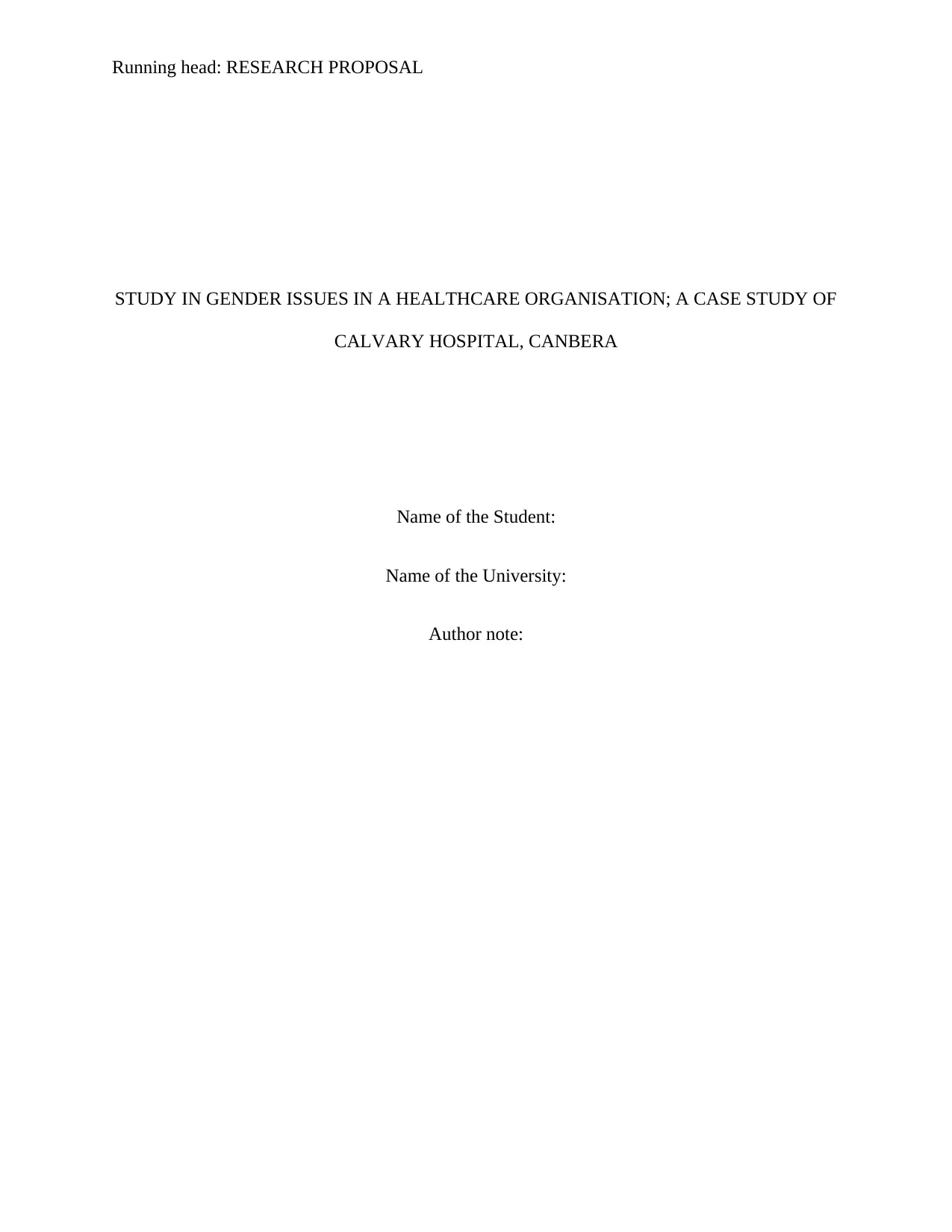
Running head: RESEARCH PROPOSAL
STUDY IN GENDER ISSUES IN A HEALTHCARE ORGANISATION; A CASE STUDY OF
CALVARY HOSPITAL, CANBERA
Name of the Student:
Name of the University:
Author note:
STUDY IN GENDER ISSUES IN A HEALTHCARE ORGANISATION; A CASE STUDY OF
CALVARY HOSPITAL, CANBERA
Name of the Student:
Name of the University:
Author note:
Paraphrase This Document
Need a fresh take? Get an instant paraphrase of this document with our AI Paraphraser

1RESEARCH PROPOSAL
Executive summary
The purpose of this research is to construct a research proposal for qualitative analysis of gender
issues in a health care unit in Australia. Further, the theoretical framework and research
methodology is outlined thoroughly. The foundation of the research is in the ontology methods
as well as the epistemology of the knowledge that have been gained while doing the research in
the following topic. The healthcare organisations are very important part of economy and thus
cover the employment part of the world. In some part of the world women faces difficulty in
being recruited because of gender inequality. Thus making that part of population laggards in job
market. In addition, the discrimination in the gender and inequality matters in wages in an
organisation has been also highlighted in the research
Executive summary
The purpose of this research is to construct a research proposal for qualitative analysis of gender
issues in a health care unit in Australia. Further, the theoretical framework and research
methodology is outlined thoroughly. The foundation of the research is in the ontology methods
as well as the epistemology of the knowledge that have been gained while doing the research in
the following topic. The healthcare organisations are very important part of economy and thus
cover the employment part of the world. In some part of the world women faces difficulty in
being recruited because of gender inequality. Thus making that part of population laggards in job
market. In addition, the discrimination in the gender and inequality matters in wages in an
organisation has been also highlighted in the research
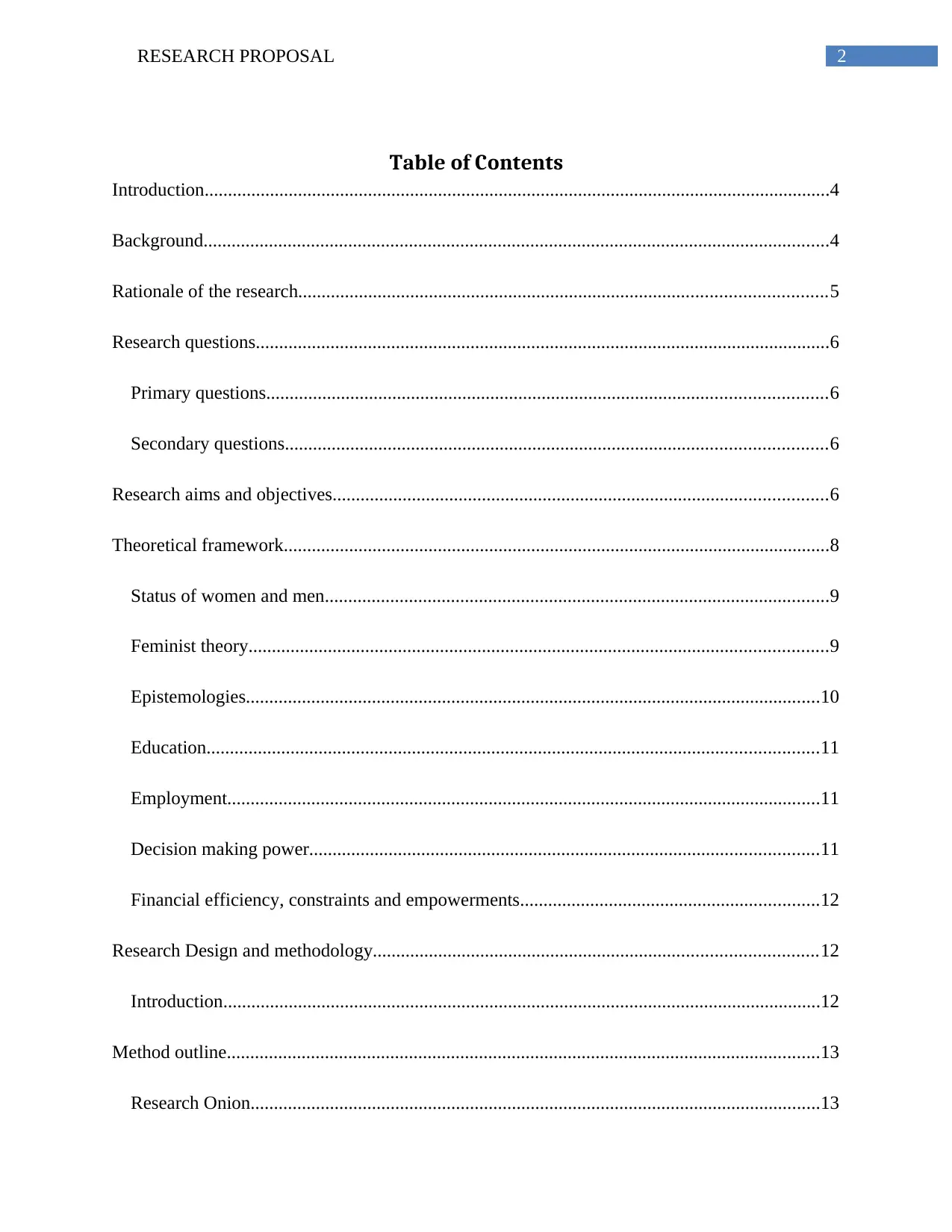
2RESEARCH PROPOSAL
Table of Contents
Introduction......................................................................................................................................4
Background......................................................................................................................................4
Rationale of the research.................................................................................................................5
Research questions...........................................................................................................................6
Primary questions........................................................................................................................6
Secondary questions....................................................................................................................6
Research aims and objectives..........................................................................................................6
Theoretical framework.....................................................................................................................8
Status of women and men............................................................................................................9
Feminist theory............................................................................................................................9
Epistemologies...........................................................................................................................10
Education...................................................................................................................................11
Employment...............................................................................................................................11
Decision making power.............................................................................................................11
Financial efficiency, constraints and empowerments................................................................12
Research Design and methodology...............................................................................................12
Introduction................................................................................................................................12
Method outline...............................................................................................................................13
Research Onion..........................................................................................................................13
Table of Contents
Introduction......................................................................................................................................4
Background......................................................................................................................................4
Rationale of the research.................................................................................................................5
Research questions...........................................................................................................................6
Primary questions........................................................................................................................6
Secondary questions....................................................................................................................6
Research aims and objectives..........................................................................................................6
Theoretical framework.....................................................................................................................8
Status of women and men............................................................................................................9
Feminist theory............................................................................................................................9
Epistemologies...........................................................................................................................10
Education...................................................................................................................................11
Employment...............................................................................................................................11
Decision making power.............................................................................................................11
Financial efficiency, constraints and empowerments................................................................12
Research Design and methodology...............................................................................................12
Introduction................................................................................................................................12
Method outline...............................................................................................................................13
Research Onion..........................................................................................................................13
⊘ This is a preview!⊘
Do you want full access?
Subscribe today to unlock all pages.

Trusted by 1+ million students worldwide
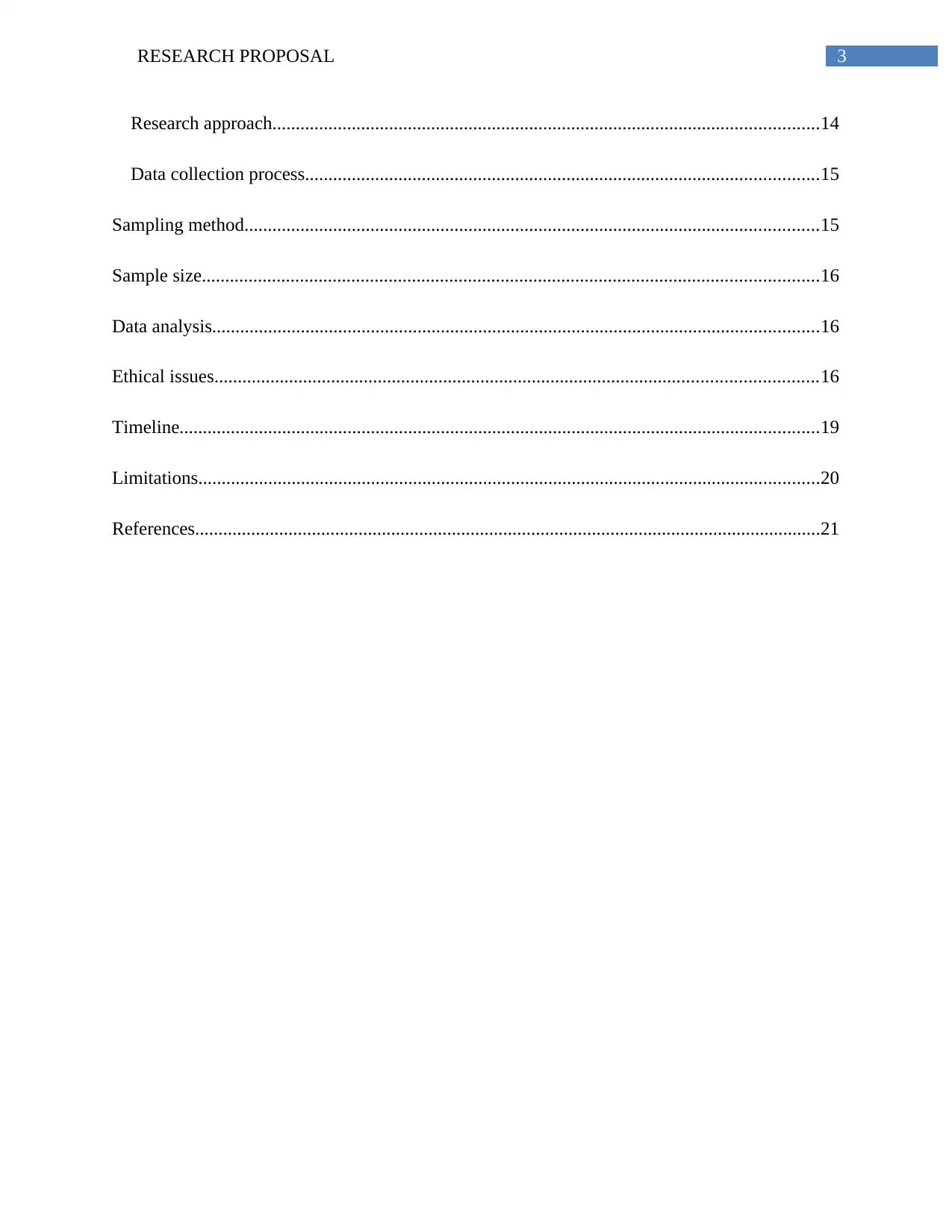
3RESEARCH PROPOSAL
Research approach.....................................................................................................................14
Data collection process..............................................................................................................15
Sampling method...........................................................................................................................15
Sample size....................................................................................................................................16
Data analysis..................................................................................................................................16
Ethical issues.................................................................................................................................16
Timeline.........................................................................................................................................19
Limitations.....................................................................................................................................20
References......................................................................................................................................21
Research approach.....................................................................................................................14
Data collection process..............................................................................................................15
Sampling method...........................................................................................................................15
Sample size....................................................................................................................................16
Data analysis..................................................................................................................................16
Ethical issues.................................................................................................................................16
Timeline.........................................................................................................................................19
Limitations.....................................................................................................................................20
References......................................................................................................................................21
Paraphrase This Document
Need a fresh take? Get an instant paraphrase of this document with our AI Paraphraser
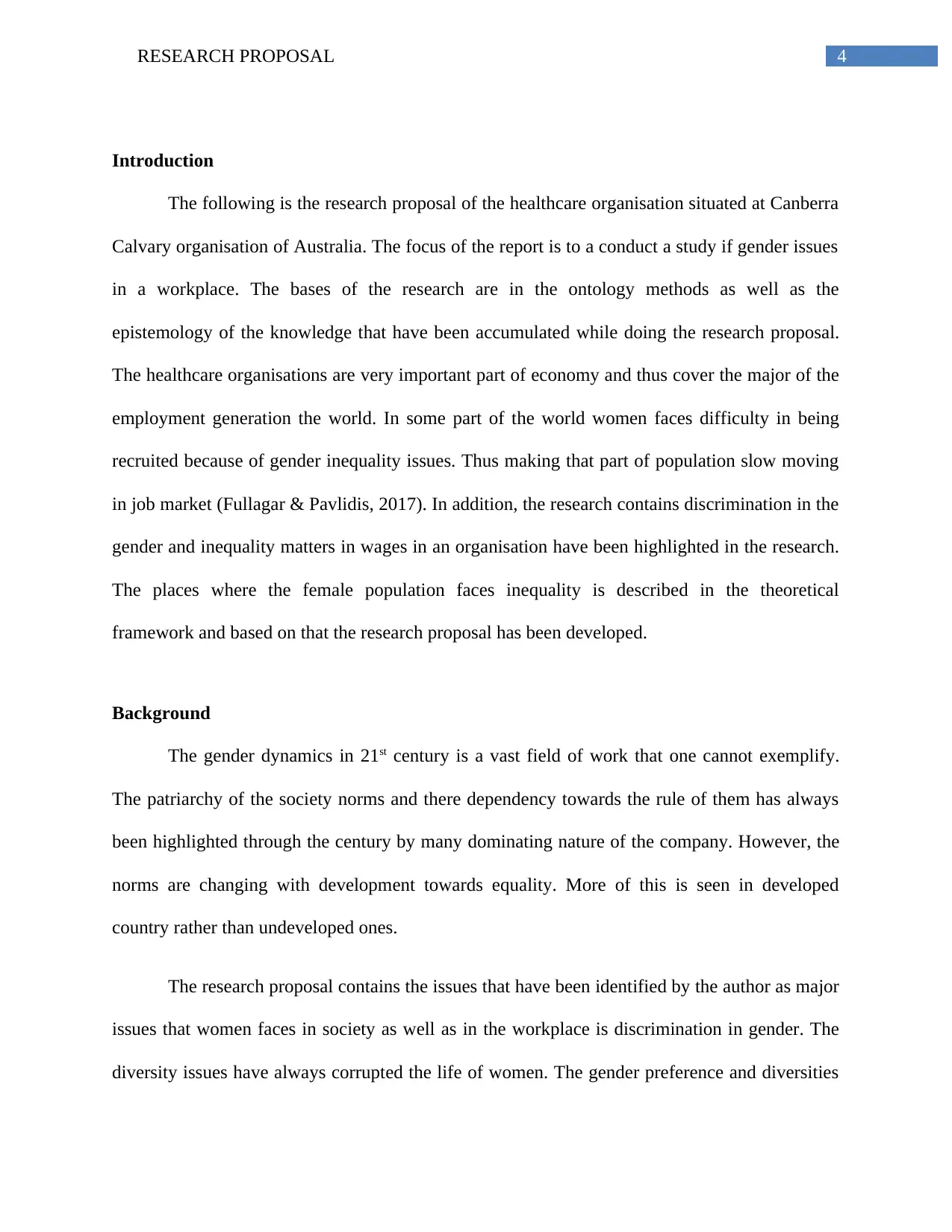
4RESEARCH PROPOSAL
Introduction
The following is the research proposal of the healthcare organisation situated at Canberra
Calvary organisation of Australia. The focus of the report is to a conduct a study if gender issues
in a workplace. The bases of the research are in the ontology methods as well as the
epistemology of the knowledge that have been accumulated while doing the research proposal.
The healthcare organisations are very important part of economy and thus cover the major of the
employment generation the world. In some part of the world women faces difficulty in being
recruited because of gender inequality issues. Thus making that part of population slow moving
in job market (Fullagar & Pavlidis, 2017). In addition, the research contains discrimination in the
gender and inequality matters in wages in an organisation have been highlighted in the research.
The places where the female population faces inequality is described in the theoretical
framework and based on that the research proposal has been developed.
Background
The gender dynamics in 21st century is a vast field of work that one cannot exemplify.
The patriarchy of the society norms and there dependency towards the rule of them has always
been highlighted through the century by many dominating nature of the company. However, the
norms are changing with development towards equality. More of this is seen in developed
country rather than undeveloped ones.
The research proposal contains the issues that have been identified by the author as major
issues that women faces in society as well as in the workplace is discrimination in gender. The
diversity issues have always corrupted the life of women. The gender preference and diversities
Introduction
The following is the research proposal of the healthcare organisation situated at Canberra
Calvary organisation of Australia. The focus of the report is to a conduct a study if gender issues
in a workplace. The bases of the research are in the ontology methods as well as the
epistemology of the knowledge that have been accumulated while doing the research proposal.
The healthcare organisations are very important part of economy and thus cover the major of the
employment generation the world. In some part of the world women faces difficulty in being
recruited because of gender inequality issues. Thus making that part of population slow moving
in job market (Fullagar & Pavlidis, 2017). In addition, the research contains discrimination in the
gender and inequality matters in wages in an organisation have been highlighted in the research.
The places where the female population faces inequality is described in the theoretical
framework and based on that the research proposal has been developed.
Background
The gender dynamics in 21st century is a vast field of work that one cannot exemplify.
The patriarchy of the society norms and there dependency towards the rule of them has always
been highlighted through the century by many dominating nature of the company. However, the
norms are changing with development towards equality. More of this is seen in developed
country rather than undeveloped ones.
The research proposal contains the issues that have been identified by the author as major
issues that women faces in society as well as in the workplace is discrimination in gender. The
diversity issues have always corrupted the life of women. The gender preference and diversities
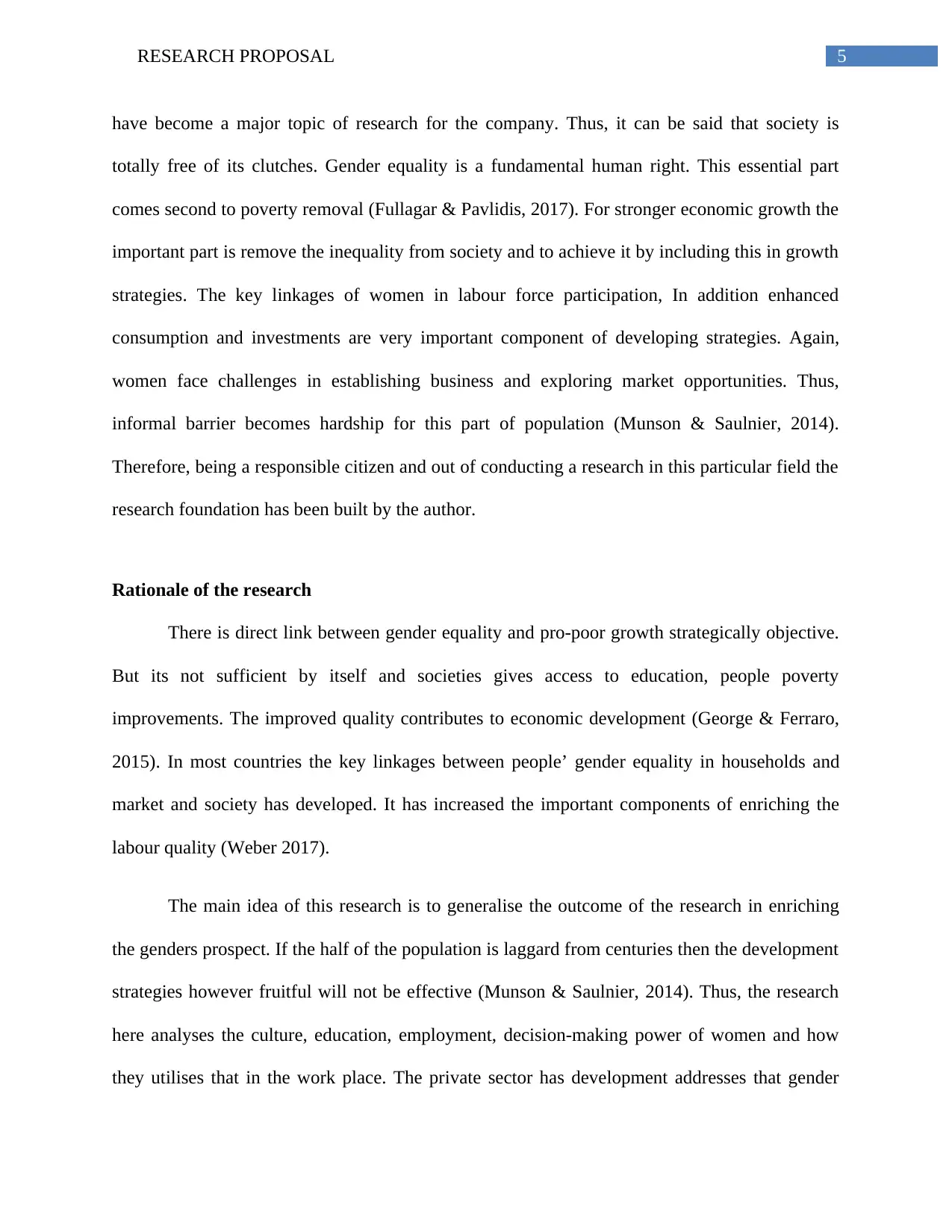
5RESEARCH PROPOSAL
have become a major topic of research for the company. Thus, it can be said that society is
totally free of its clutches. Gender equality is a fundamental human right. This essential part
comes second to poverty removal (Fullagar & Pavlidis, 2017). For stronger economic growth the
important part is remove the inequality from society and to achieve it by including this in growth
strategies. The key linkages of women in labour force participation, In addition enhanced
consumption and investments are very important component of developing strategies. Again,
women face challenges in establishing business and exploring market opportunities. Thus,
informal barrier becomes hardship for this part of population (Munson & Saulnier, 2014).
Therefore, being a responsible citizen and out of conducting a research in this particular field the
research foundation has been built by the author.
Rationale of the research
There is direct link between gender equality and pro-poor growth strategically objective.
But its not sufficient by itself and societies gives access to education, people poverty
improvements. The improved quality contributes to economic development (George & Ferraro,
2015). In most countries the key linkages between people’ gender equality in households and
market and society has developed. It has increased the important components of enriching the
labour quality (Weber 2017).
The main idea of this research is to generalise the outcome of the research in enriching
the genders prospect. If the half of the population is laggard from centuries then the development
strategies however fruitful will not be effective (Munson & Saulnier, 2014). Thus, the research
here analyses the culture, education, employment, decision-making power of women and how
they utilises that in the work place. The private sector has development addresses that gender
have become a major topic of research for the company. Thus, it can be said that society is
totally free of its clutches. Gender equality is a fundamental human right. This essential part
comes second to poverty removal (Fullagar & Pavlidis, 2017). For stronger economic growth the
important part is remove the inequality from society and to achieve it by including this in growth
strategies. The key linkages of women in labour force participation, In addition enhanced
consumption and investments are very important component of developing strategies. Again,
women face challenges in establishing business and exploring market opportunities. Thus,
informal barrier becomes hardship for this part of population (Munson & Saulnier, 2014).
Therefore, being a responsible citizen and out of conducting a research in this particular field the
research foundation has been built by the author.
Rationale of the research
There is direct link between gender equality and pro-poor growth strategically objective.
But its not sufficient by itself and societies gives access to education, people poverty
improvements. The improved quality contributes to economic development (George & Ferraro,
2015). In most countries the key linkages between people’ gender equality in households and
market and society has developed. It has increased the important components of enriching the
labour quality (Weber 2017).
The main idea of this research is to generalise the outcome of the research in enriching
the genders prospect. If the half of the population is laggard from centuries then the development
strategies however fruitful will not be effective (Munson & Saulnier, 2014). Thus, the research
here analyses the culture, education, employment, decision-making power of women and how
they utilises that in the work place. The private sector has development addresses that gender
⊘ This is a preview!⊘
Do you want full access?
Subscribe today to unlock all pages.

Trusted by 1+ million students worldwide

6RESEARCH PROPOSAL
reform inheritance laws. Women do not always reap the benefit of economic production though
they have done most of the work. The main criteria of the research have been developed to assess
to analyse if there is any wage discrimination among the gender (George & Ferraro, 2015).
Along with having any decision –making power in the work place, chance of negotiation as well
as the opportunities of being productive. Therefore, the research has been outlined as such that
author would be able to analyse current condition of the gender related and gender affected
issues that are taking place in the healthcare unit (Weber, 2015).
Research questions
Primary questions
Is there any gender related issues in the health care hospital?
Secondary questions
Is there wage discrimination related to gender inequality in the hospital?
Is there any policy in the hospital that favours the male employees rather than the female
candidates?
Is women has lesser decision making power than the males in higher position?
What can be recommended to the company for eliminating the issues related to gender?
Research aims and objectives
The aim of this research is to analyse gender related issues of the organisation Calvary
Hospital.
The primary objective of the research is
reform inheritance laws. Women do not always reap the benefit of economic production though
they have done most of the work. The main criteria of the research have been developed to assess
to analyse if there is any wage discrimination among the gender (George & Ferraro, 2015).
Along with having any decision –making power in the work place, chance of negotiation as well
as the opportunities of being productive. Therefore, the research has been outlined as such that
author would be able to analyse current condition of the gender related and gender affected
issues that are taking place in the healthcare unit (Weber, 2015).
Research questions
Primary questions
Is there any gender related issues in the health care hospital?
Secondary questions
Is there wage discrimination related to gender inequality in the hospital?
Is there any policy in the hospital that favours the male employees rather than the female
candidates?
Is women has lesser decision making power than the males in higher position?
What can be recommended to the company for eliminating the issues related to gender?
Research aims and objectives
The aim of this research is to analyse gender related issues of the organisation Calvary
Hospital.
The primary objective of the research is
Paraphrase This Document
Need a fresh take? Get an instant paraphrase of this document with our AI Paraphraser

7RESEARCH PROPOSAL
To analyse the gender related issue in the organisation.
To analyse if there any wage discrimination issues related to genders inequality.
To analyse the decision making power of the female candidate over males in the
organisation.
To recommend policy evaluation or incorporation of standard procedures in the health
care unit in Australia.
To analyse the gender related issue in the organisation.
To analyse if there any wage discrimination issues related to genders inequality.
To analyse the decision making power of the female candidate over males in the
organisation.
To recommend policy evaluation or incorporation of standard procedures in the health
care unit in Australia.
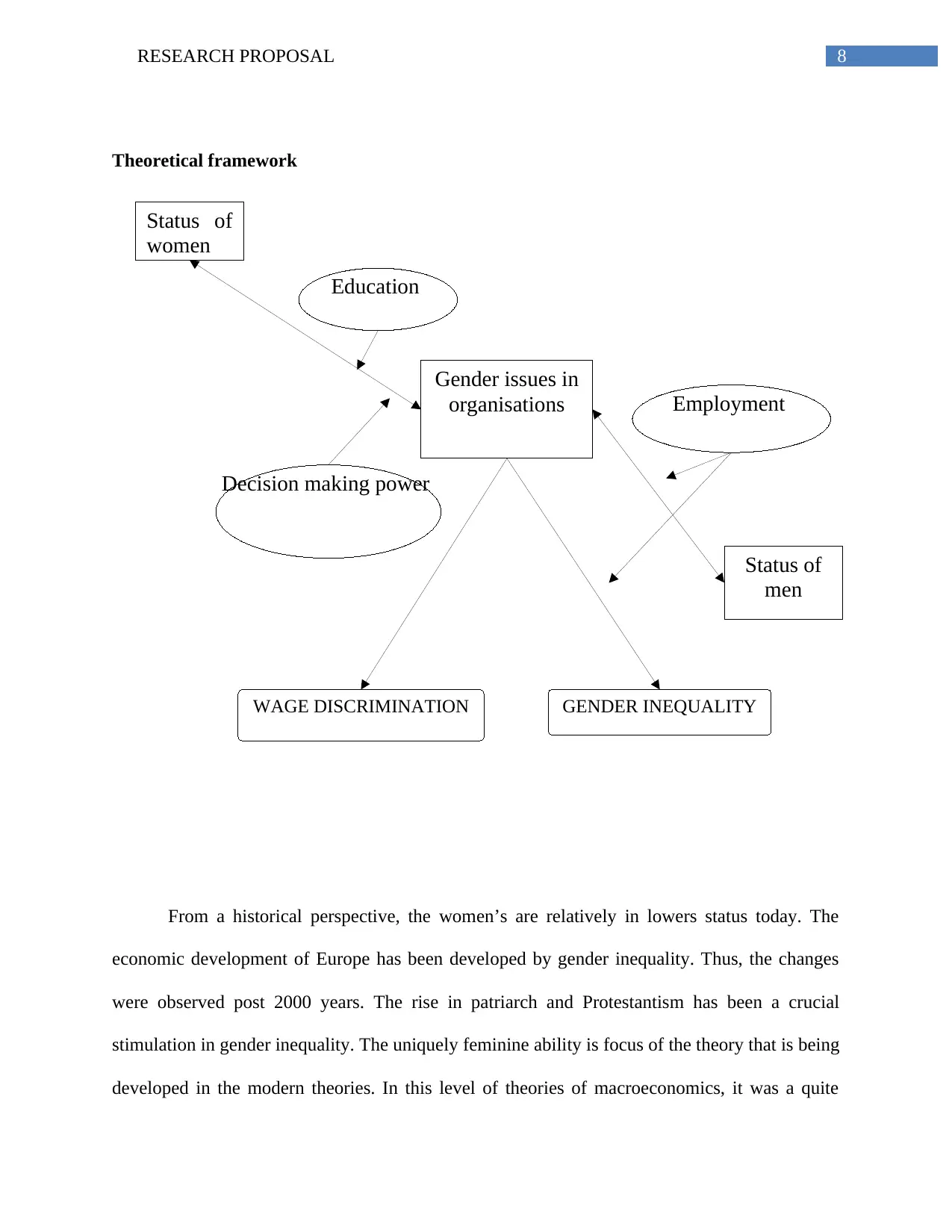
8RESEARCH PROPOSAL
Status of
women
Gender issues in
organisations
Status of
men
Education
Employment
Decision making power
WAGE DISCRIMINATION GENDER INEQUALITY
Theoretical framework
From a historical perspective, the women’s are relatively in lowers status today. The
economic development of Europe has been developed by gender inequality. Thus, the changes
were observed post 2000 years. The rise in patriarch and Protestantism has been a crucial
stimulation in gender inequality. The uniquely feminine ability is focus of the theory that is being
developed in the modern theories. In this level of theories of macroeconomics, it was a quite
Status of
women
Gender issues in
organisations
Status of
men
Education
Employment
Decision making power
WAGE DISCRIMINATION GENDER INEQUALITY
Theoretical framework
From a historical perspective, the women’s are relatively in lowers status today. The
economic development of Europe has been developed by gender inequality. Thus, the changes
were observed post 2000 years. The rise in patriarch and Protestantism has been a crucial
stimulation in gender inequality. The uniquely feminine ability is focus of the theory that is being
developed in the modern theories. In this level of theories of macroeconomics, it was a quite
⊘ This is a preview!⊘
Do you want full access?
Subscribe today to unlock all pages.

Trusted by 1+ million students worldwide

9RESEARCH PROPOSAL
difficult process to verbalise effects of the status of women, education of women, motivating
power of women on showing the effect of aggregate growth for econometric reasons among
others (Weber 2017). On the other hand, there certainly more of microeconomics factors, that the
literature in the study might help in being considerate of how the economic growth and
development might be affected by direct or indirect restrictions or exclusion that women have
adjusted to (Deepta & Müller, 2016). There is relevancy question predominantly in developing
countries. It is argued that the continuous failures of the western organizations in different field
to help the developing countries in further development have been as a result of the failure to
account for the incentives people face (Connell, 2014). Those in the lower level of development
work generally acknowledge the importance of the status of women in development (Deepta &
Müller, 2016).
Status of women and men
The women’s are globally expected to be centred at home rather than the male. The
societal norms and rules are defined as such that exclude women’s from certain leadership
positions and particular paid employment opportunities. The resulting segregation is the focus of
the specialisation studies of Feminist theories (Benería et al., 2015).
Feminist theory
This theory focuses on gender inequality of society to women. History has been the
evidence of the discriminations done between the men and women. Thus, they are objectified
more than necessary in situations. This phase is called feminist critique phase in an organisation.
Thus, the distinct feminine discipline has argued the relativity of the theories. This theory of
feminist includes the discrimination, objectification, patriarchy, oppression, stereotyping and
aesthetics of the gender inequality (Stanley, 2013).
difficult process to verbalise effects of the status of women, education of women, motivating
power of women on showing the effect of aggregate growth for econometric reasons among
others (Weber 2017). On the other hand, there certainly more of microeconomics factors, that the
literature in the study might help in being considerate of how the economic growth and
development might be affected by direct or indirect restrictions or exclusion that women have
adjusted to (Deepta & Müller, 2016). There is relevancy question predominantly in developing
countries. It is argued that the continuous failures of the western organizations in different field
to help the developing countries in further development have been as a result of the failure to
account for the incentives people face (Connell, 2014). Those in the lower level of development
work generally acknowledge the importance of the status of women in development (Deepta &
Müller, 2016).
Status of women and men
The women’s are globally expected to be centred at home rather than the male. The
societal norms and rules are defined as such that exclude women’s from certain leadership
positions and particular paid employment opportunities. The resulting segregation is the focus of
the specialisation studies of Feminist theories (Benería et al., 2015).
Feminist theory
This theory focuses on gender inequality of society to women. History has been the
evidence of the discriminations done between the men and women. Thus, they are objectified
more than necessary in situations. This phase is called feminist critique phase in an organisation.
Thus, the distinct feminine discipline has argued the relativity of the theories. This theory of
feminist includes the discrimination, objectification, patriarchy, oppression, stereotyping and
aesthetics of the gender inequality (Stanley, 2013).
Paraphrase This Document
Need a fresh take? Get an instant paraphrase of this document with our AI Paraphraser
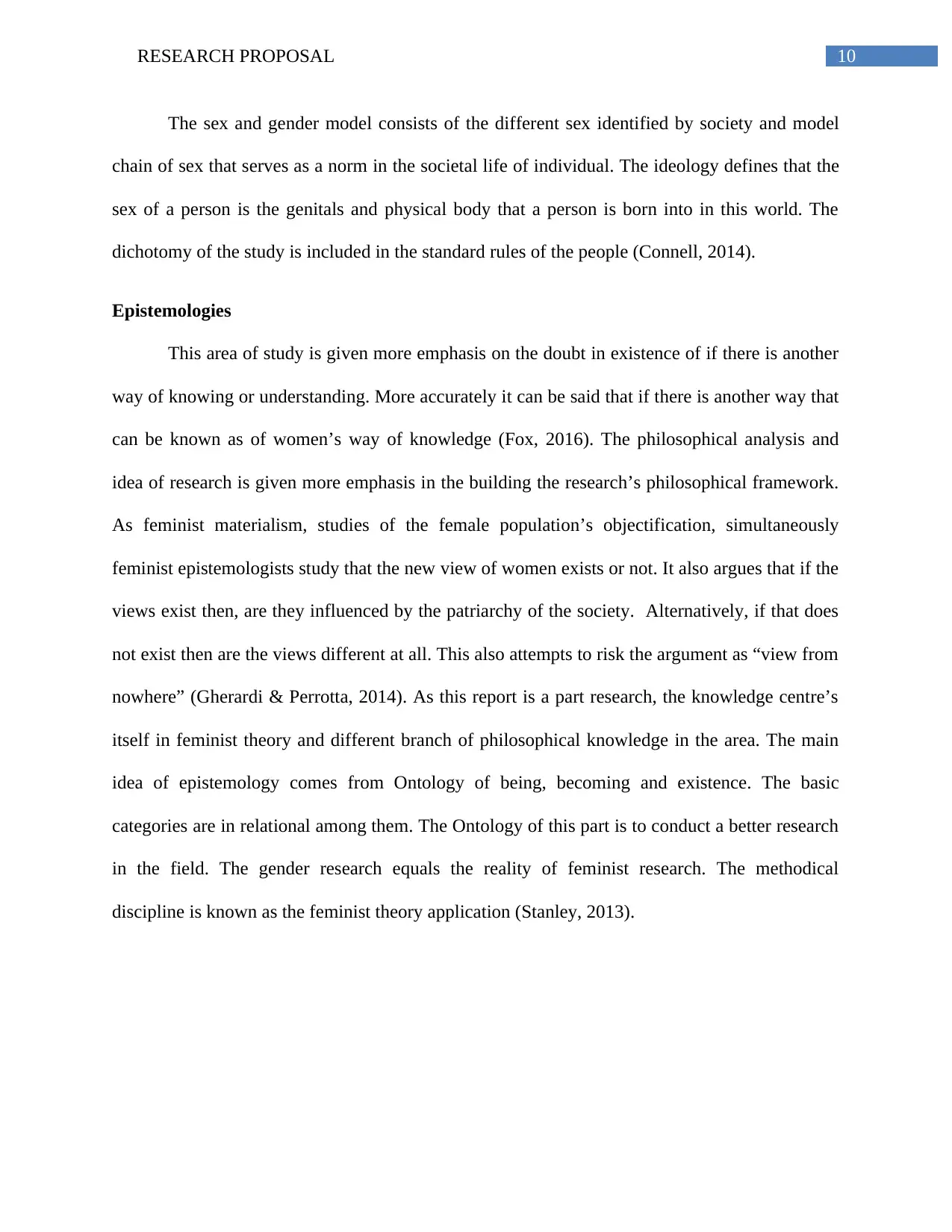
10RESEARCH PROPOSAL
The sex and gender model consists of the different sex identified by society and model
chain of sex that serves as a norm in the societal life of individual. The ideology defines that the
sex of a person is the genitals and physical body that a person is born into in this world. The
dichotomy of the study is included in the standard rules of the people (Connell, 2014).
Epistemologies
This area of study is given more emphasis on the doubt in existence of if there is another
way of knowing or understanding. More accurately it can be said that if there is another way that
can be known as of women’s way of knowledge (Fox, 2016). The philosophical analysis and
idea of research is given more emphasis in the building the research’s philosophical framework.
As feminist materialism, studies of the female population’s objectification, simultaneously
feminist epistemologists study that the new view of women exists or not. It also argues that if the
views exist then, are they influenced by the patriarchy of the society. Alternatively, if that does
not exist then are the views different at all. This also attempts to risk the argument as “view from
nowhere” (Gherardi & Perrotta, 2014). As this report is a part research, the knowledge centre’s
itself in feminist theory and different branch of philosophical knowledge in the area. The main
idea of epistemology comes from Ontology of being, becoming and existence. The basic
categories are in relational among them. The Ontology of this part is to conduct a better research
in the field. The gender research equals the reality of feminist research. The methodical
discipline is known as the feminist theory application (Stanley, 2013).
The sex and gender model consists of the different sex identified by society and model
chain of sex that serves as a norm in the societal life of individual. The ideology defines that the
sex of a person is the genitals and physical body that a person is born into in this world. The
dichotomy of the study is included in the standard rules of the people (Connell, 2014).
Epistemologies
This area of study is given more emphasis on the doubt in existence of if there is another
way of knowing or understanding. More accurately it can be said that if there is another way that
can be known as of women’s way of knowledge (Fox, 2016). The philosophical analysis and
idea of research is given more emphasis in the building the research’s philosophical framework.
As feminist materialism, studies of the female population’s objectification, simultaneously
feminist epistemologists study that the new view of women exists or not. It also argues that if the
views exist then, are they influenced by the patriarchy of the society. Alternatively, if that does
not exist then are the views different at all. This also attempts to risk the argument as “view from
nowhere” (Gherardi & Perrotta, 2014). As this report is a part research, the knowledge centre’s
itself in feminist theory and different branch of philosophical knowledge in the area. The main
idea of epistemology comes from Ontology of being, becoming and existence. The basic
categories are in relational among them. The Ontology of this part is to conduct a better research
in the field. The gender research equals the reality of feminist research. The methodical
discipline is known as the feminist theory application (Stanley, 2013).
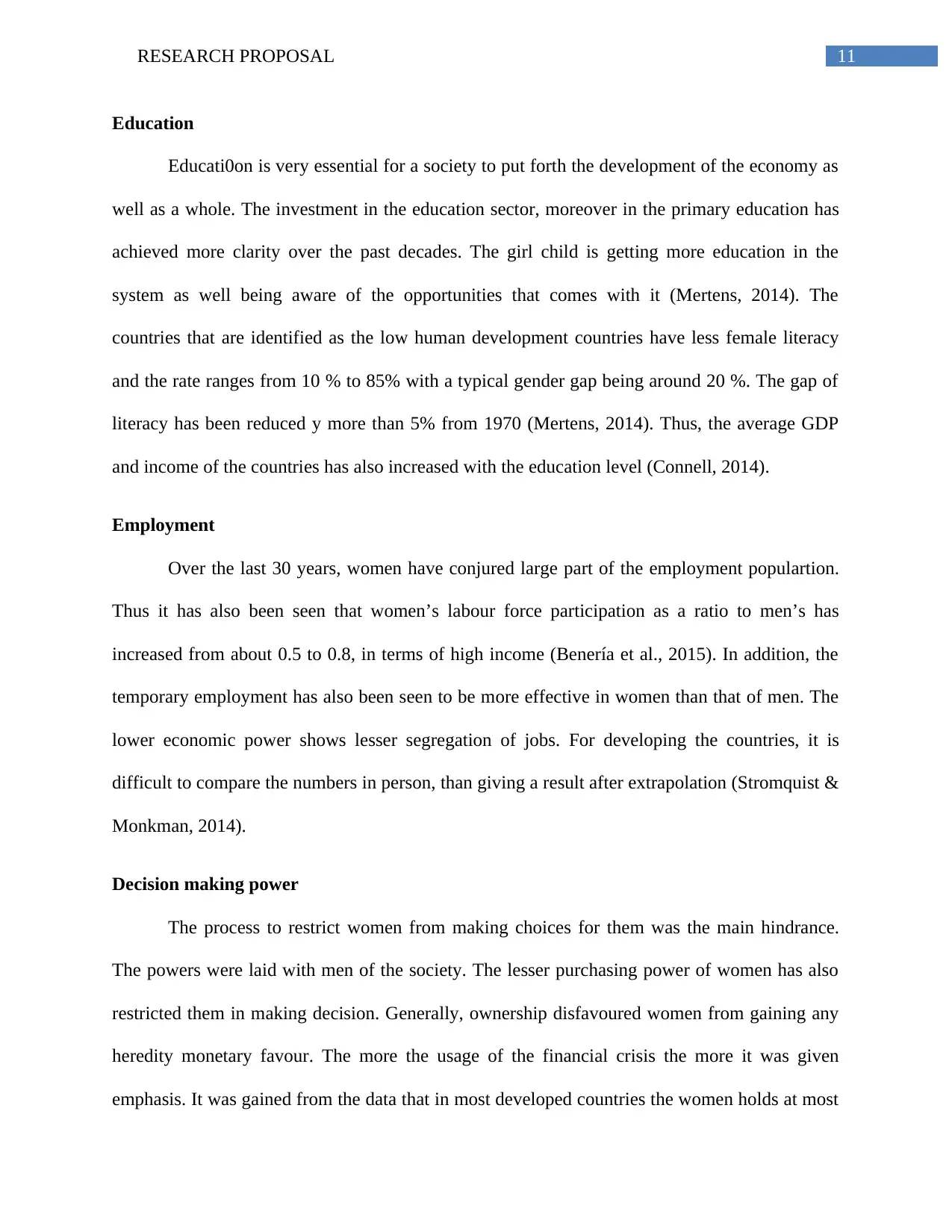
11RESEARCH PROPOSAL
Education
Educati0on is very essential for a society to put forth the development of the economy as
well as a whole. The investment in the education sector, moreover in the primary education has
achieved more clarity over the past decades. The girl child is getting more education in the
system as well being aware of the opportunities that comes with it (Mertens, 2014). The
countries that are identified as the low human development countries have less female literacy
and the rate ranges from 10 % to 85% with a typical gender gap being around 20 %. The gap of
literacy has been reduced y more than 5% from 1970 (Mertens, 2014). Thus, the average GDP
and income of the countries has also increased with the education level (Connell, 2014).
Employment
Over the last 30 years, women have conjured large part of the employment populartion.
Thus it has also been seen that women’s labour force participation as a ratio to men’s has
increased from about 0.5 to 0.8, in terms of high income (Benería et al., 2015). In addition, the
temporary employment has also been seen to be more effective in women than that of men. The
lower economic power shows lesser segregation of jobs. For developing the countries, it is
difficult to compare the numbers in person, than giving a result after extrapolation (Stromquist &
Monkman, 2014).
Decision making power
The process to restrict women from making choices for them was the main hindrance.
The powers were laid with men of the society. The lesser purchasing power of women has also
restricted them in making decision. Generally, ownership disfavoured women from gaining any
heredity monetary favour. The more the usage of the financial crisis the more it was given
emphasis. It was gained from the data that in most developed countries the women holds at most
Education
Educati0on is very essential for a society to put forth the development of the economy as
well as a whole. The investment in the education sector, moreover in the primary education has
achieved more clarity over the past decades. The girl child is getting more education in the
system as well being aware of the opportunities that comes with it (Mertens, 2014). The
countries that are identified as the low human development countries have less female literacy
and the rate ranges from 10 % to 85% with a typical gender gap being around 20 %. The gap of
literacy has been reduced y more than 5% from 1970 (Mertens, 2014). Thus, the average GDP
and income of the countries has also increased with the education level (Connell, 2014).
Employment
Over the last 30 years, women have conjured large part of the employment populartion.
Thus it has also been seen that women’s labour force participation as a ratio to men’s has
increased from about 0.5 to 0.8, in terms of high income (Benería et al., 2015). In addition, the
temporary employment has also been seen to be more effective in women than that of men. The
lower economic power shows lesser segregation of jobs. For developing the countries, it is
difficult to compare the numbers in person, than giving a result after extrapolation (Stromquist &
Monkman, 2014).
Decision making power
The process to restrict women from making choices for them was the main hindrance.
The powers were laid with men of the society. The lesser purchasing power of women has also
restricted them in making decision. Generally, ownership disfavoured women from gaining any
heredity monetary favour. The more the usage of the financial crisis the more it was given
emphasis. It was gained from the data that in most developed countries the women holds at most
⊘ This is a preview!⊘
Do you want full access?
Subscribe today to unlock all pages.

Trusted by 1+ million students worldwide
1 out of 25
Related Documents
Your All-in-One AI-Powered Toolkit for Academic Success.
+13062052269
info@desklib.com
Available 24*7 on WhatsApp / Email
![[object Object]](/_next/static/media/star-bottom.7253800d.svg)
Unlock your academic potential
Copyright © 2020–2025 A2Z Services. All Rights Reserved. Developed and managed by ZUCOL.





